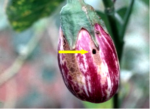Eggplant fruit and shoot borer
Leucinodes orbonalis
Lepidoptera: Pyralidae
The eggplant fruit and shoot borer is fund throughout the tropics in Asia and Africa. It is only a minor pest in the Americas, where it is closely related to the American species Neoleucinoides elegantalis. There are many species in the genus Leucinodes.
Why is eggplant fruit borer difficult to control?
- larvae are hidden in the fruit and do not come into contact with insecticide
Host plants and damage

Eggplant fruit borer is a major insect pest on eggplant. It has also been recorded on fruit of tomato (Lycopersicon esculentum) and tubers of potato (Solanum tuberosum).
At the vegetative stage of the crop, larvae bore through shoots and tips. At the reproductive stage of the crop they bore through flowers and fruits.
Wilting may occur if infestations are severe. Infested fruit may be unsuitable for consumption.
Morphology & biology

Oval-shaped eggs, creamy in color and 0.6-0.8 mm wide are laid singly on the leaves, flowers, and buds. A single female can lay as many as 200 eggs. Oviposition takes place during the night and incubation period lasts 3-5 days.
The larvae pass through six instars. The duration of larval development depends on temperature and on the quality of nourishment. Under favorable conditions the larval period last for 8-14 days. First instars are creamy white, whereas lasts instars turn to a pinkish brown color. Fifth instars can reach a length of 20 mm.
Pupation occurs in rolled leaves or on the ground. The pupal stage is 8-10 days.
Adults are brown with black dorsal spots. Wings are white with brown, black, and orange markings. The hind wings have small black spots. Wings are covered with hairs along the apical margins. They have a wingspan of 23-24 mm. Adult longevity ranges from 22-27 days.
Monitoring
Damaged fruit are noted by the presence of entry and exit holes. Look for holes in fruits and shoots. The holes appear darkened surrounded with brownish areas. As fruit increase in size the holes can heal partially and become more difficult to find.
A sexpheromone, produced by virgin females, could be utilized for monitoring purposes.
Pest management
It is reported from field experiments, that adults start colonizing eggplants the second week after transplanting.
Biological control
Insect parasitoids such as Eriborus sinicus and Trathala flavoorbitalis are promising candidates for biological control of eggplant fruit and shoot borers.
Entomopathogenic nematodes have not been recorded attacking eggplant fruit and shoot borer in the field, but Steinerma carpocapsae produced 73.3 % mortality in the laboratory in 72 hours.
Cultural control
By removing damaged fruit the frequency of insecticide applications can be reduced.
Several eggplant varieties have been reported to be resistant to infestation by eggplant fruit and shoot borer. Thick skinned varieties appear to be more resistant. Biochemical factors involved include a low protein and sugar content in resistant genotypes.
The use of net barriers can prevent migration of the moth to the crop.
Since eggplant fruit and shoot borer have a narrow host range, crop rotation with non host plants can be effective.
Chemical Control
Insecticide applications must target early larval stages. Older larvae are often hidden in plant organs and therefore are beyond reach by insecticide.
Recommendations for better management:
- remove damaged fruits from the field and destroy them
- larvae are only a few hours after hatching vulnerable for insecticides, therefore repetitive sprays are needed